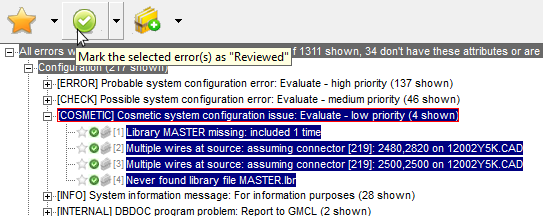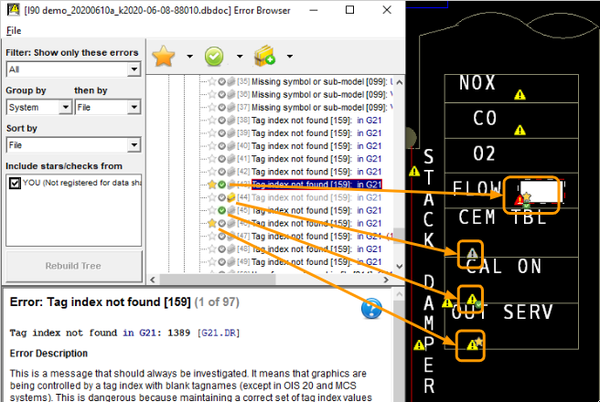Contents
About marking errors
The Error Browser provides powerful capabilities for persistently flagging and marking errors in various ways. You can flag an error with a star, indicate that you have reviewed an error, and indicate that an error is to be hidden. You can choose which errors to display in the error tree based on how they have been marked. For example, you could displayed only "starred" errors, or only "reviewed" errors.
For more information about filtering the errors in the tree, see Choosing which errors to show in the Error Browser.
Error marking options
There are three error marking possibilities: Starred, Reviewed, and Hidden. Future versions of the error browser will probably support some form of labeling capacity for generalized categorization of errors.
Each error can have any combination of markings, so use them in whatever way is convenient.
-
 Star – use to indicate that an error requires attention.
Star – use to indicate that an error requires attention.
-
 Review – use to indicate that an error has been looked at and evaluated.
Review – use to indicate that an error has been looked at and evaluated.
-
 Hide – use to indicate that an error does not need to be further examined and can be hidden from view.
Hide – use to indicate that an error does not need to be further examined and can be hidden from view.
Marking individual errors
To mark a particular error, simply click on the small gray icon to the left of the error displayed in the tree. For example, to "star" an error, click on the star icon. The icon will colorize, indicating that the error now is marked as "starred." You can turn off the star by clicking on the icon again.

You can also mark an error item by selecting it (click on it), then clicking on one of the toolbar icons, or by choosing the appropriate option from the toolbar drop-down menus. The toolbar drop-down menu also contains options for unmarking error items.

Marking groups of errors
Any selected group of errors can be marked in these ways. You can select an entire branch of the tree by clicking on the "parent" of the branch. Clicking on one of the toolbar icons will then cause every error in the branch to be marked. Shift-Click can be used to select groups of adjacent errors. Ctrl+Click can be used to select multiple errors. Selecting a branch parent node in the tree will always cause all the errors in it to be selected.

Displaying tree items based on how they are marked
Marking error items is a powerful technique, because it allows you flag important errors, keep track of those you have reviewed, and (perhaps most importantly) to hide those that you don't need to see. The Show these errors combobox to the left of the error tree allows you to select which errors you wish to display in the tree, based on how they are marked.
For example, if you wanted to hide all error with "COSMETIC" severity (these errors represent issues that could be tidied up, but are not functional errors), you could do the following:
- Choose "Active" in the Show these errors combobox and click Rebuild. That causes all non-hidden errors to be displayed in the tree.
- Choose "Severity" in the Group errors by combobox and click Rebuild.
- In the tree select the "COSMETIC" branch.
- Click the
 icon.
icon.

The hidden items become "grayed." If you then click Rebuild, the tree will be refreshed. The errors you marked as hidden are removed from the tree, because they are no longer "Active." Note that the "COSMETIC" branch is gone and that the title now notes the missing errors.

To see the hidden errors, choose "Hidden" in the Show these errors combobox and click Rebuild.

To see all the errors, both hidden and not, choose "All" in the Show these errors combobox and click Rebuild.

Similar approaches can be used to focus on starred errors, errors that have not been reviewed yet, and so forth. Errors can be grouped in many ways. For example, if you wanted to hide all the errors associated with a particular PCU, simply Group errors by "Loop-PCU", select the branch of interest, then click on the ![]() icon.
icon.
Error markers in the main browser
When you mark an error in the error browser, the star or check is added to the corresponding error in the main browser. A hidden error is gray. A selected error is red.
![]() Note: As of DBDOC 11.2, all errors are always displayed in the main browser, even if they are filtered out in the error browser.
Note: As of DBDOC 11.2, all errors are always displayed in the main browser, even if they are filtered out in the error browser.
